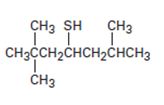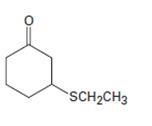
Concept explainers
a)

Interpretation:
The name of the compound given is to be stated.
Concept introduction:
Thioalcohols are named as derivatives of the parent
To give:
The name of the compound shown.
b)

Interpretation:
The name of the compound given is to be stated.
Concept introduction:
Thioalcohols are named as derivatives of the parent alkane using the suffix –al. The longest carbon chain containing the thiol group is chosen and the parent name is derived by replacing the ending –e with –thiol. The alkane chain is numbered beginning at the end nearer to the thiol group. The substituents are numbered according to their position on the chain. The name is written listing the substituents in the alphabetical order and indicating the position to which –SH is bonded.
To give:
The name of the compound shown.
c)

Interpretation:
The name of the compound given is to be stated.
Concept introduction:
In naming cyclic thioalcohols the parent name is derived from the cycloalkene ring by replacing –e of the cycloalkene with –thiol. The ring is numbered from the carbon with –SH in such a way that lowest number possible is given to the other
To give:
The name of the compound shown.
d)

Interpretation:
The name of the compound given is to be stated.
Concept introduction:
Simple sulfides are with no other functional groups are named by identifying the two organic substituents and adding the word sulfide. If other functional groups are present, the sulfide part is considered as an alkylthio substituent.
To give:
The name of the sulfide shown.
e)

Interpretation:
The name of the compound given is to be stated.
Concept introduction:
Simple sulfides are with no other functional groups are named by identifying the two organic substituents and adding the word sulfide. If other functional groups are present, the sulfide part is considered as an alkylthio substituent.
To give:
The name of the disulfide shown.
f)

Interpretation:
The name of the compound given is to be stated.
Concept introduction:
Simple sulfides are with no other functional groups are named by identifying the two organic substituents and adding the word sulfide. If other functional groups are present, the sulfide part is considered as an alkylthio substituent.
To give:
The name of the compound shown.
Want to see the full answer?
Check out a sample textbook solution
Chapter 18 Solutions
EP ORGANIC CHEMISTRY,24 MONTH-OWLV2
- Consider the reaction of the cyclopentanone derivative shown below. i) NaOCH2CH3 CH3CH2OH, 25°C ii) CH3!arrow_forwardWhat constitutes a 'reference material', and why does its utilization play a critical role in the chemical analysis of food products? Provide examples.arrow_forwardExplain what calibration is and why it is essential in relation to food analysis. Provide examples.arrow_forward
- The cobalt mu-hydroxide complex cobaltate(III) of potassium is a dinuclear complex. Correct?arrow_forwardThe cobalt mi-hydroxide complex cobaltate(III) of potassium is a dinuclear complex. Correct?arrow_forward3. Arrange the different acids in Exercise B # 2 from the strongest (1) to the weakest acid (10). 1. 2. (strongest) 3. 4. 5. 6. 7. 8. 9. 10 10. (weakest)arrow_forward
- Name Section Score Date EXERCISE B pH, pOH, pка, AND PKD CALCULATIONS 1. Complete the following table. Solution [H+] [OH-] PH РОН Nature of Solution A 2 x 10-8 M B 1 x 10-7 M C D 12.3 6.8 2. The following table contains the names, formulas, ka or pka for some common acids. Fill in the blanks in the table. (17 Points) Acid Name Formula Dissociation reaction Ka pka Phosphoric acid H₂PO₁ H3PO4 H++ H₂PO 7.08 x 10-3 Dihydrogen H₂PO H₂PO H+ HPO 6.31 x 10-6 phosphate Hydrogen HPO₁ 12.4 phosphate Carbonic acid H2CO3 Hydrogen HCO 6.35 10.3 carbonate or bicarbonate Acetic acid CH,COOH 4.76 Lactic acid CH₂CHOH- COOH 1.38 x 10 Ammonium NH 5.63 x 10-10 Phenol CH₂OH 1 x 10-10 Protonated form CH3NH3* 3.16 x 10-11 of methylaminearrow_forwardIndicate whether it is true that Co(III) complexes are very stable.arrow_forwardMnO2 acts as an oxidant in the chlorine synthesis reaction.arrow_forward
- In Potassium mu-dihydroxydicobaltate (III) tetraoxalate K4[Co2(C2O4)4(OH)2], indicate whether the OH ligand type is bidentate.arrow_forwardImagine an electrochemical cell based on these two half reactions with electrolyte concentrations as given below: Oxidation: Pb(s) → Pb2+(aq, 0.10 M) + 2 e– Reduction: MnO4–(aq, 1.50 M) + 4 H+(aq, 2.0 M) + 3 e– → MnO2(s) + 2 H2O(l) Calculate Ecell (assuming temperature is standard 25 °C).arrow_forward: ☐ + Draw the Fischer projection of the most common naturally-occurring form of aspartate, with the acid group at the top and the side chain at the bottom. Important: be sure your structure shows the molecule as it would exist at physiological pH. Click and drag to start drawing a structure. ✓arrow_forward
 General Chemistry - Standalone book (MindTap Cour...ChemistryISBN:9781305580343Author:Steven D. Gammon, Ebbing, Darrell Ebbing, Steven D., Darrell; Gammon, Darrell Ebbing; Steven D. Gammon, Darrell D.; Gammon, Ebbing; Steven D. Gammon; DarrellPublisher:Cengage Learning
General Chemistry - Standalone book (MindTap Cour...ChemistryISBN:9781305580343Author:Steven D. Gammon, Ebbing, Darrell Ebbing, Steven D., Darrell; Gammon, Darrell Ebbing; Steven D. Gammon, Darrell D.; Gammon, Ebbing; Steven D. Gammon; DarrellPublisher:Cengage Learning Chemistry: Principles and ReactionsChemistryISBN:9781305079373Author:William L. Masterton, Cecile N. HurleyPublisher:Cengage Learning
Chemistry: Principles and ReactionsChemistryISBN:9781305079373Author:William L. Masterton, Cecile N. HurleyPublisher:Cengage Learning

